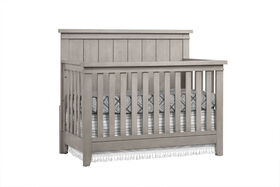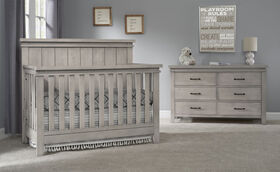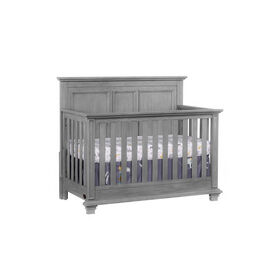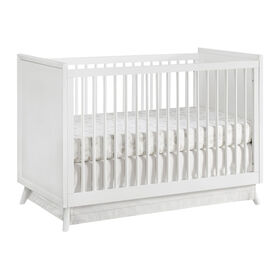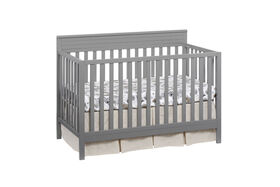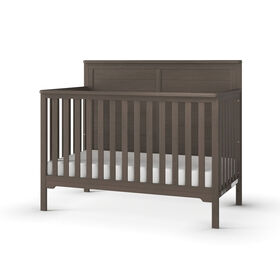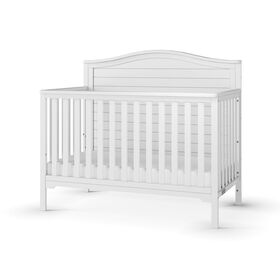Shop Babies “R” Us to choose a beautiful baby crib set or bassinet for your little one. Furnish your nursery with a versatile 4-in-1 baby bed that can be configured in different ways as baby grows: as a traditional baby crib, a toddler bed, a day bed, or a full-size bed with footboard. Families with newborns may also wish to buy a bassinet or baby cot to serve as a portable crib that allows parents to keep baby close by in any room. Explore our selection of matching nursery sets – wooden crib, dresser, change table and even nightstand – that you can coordinate to fit your design aesthetic.
Create the baby bedroom of your dreams
As you envision your baby’s nursery, think about the colour palette you prefer for a nursery set: a dreamy white crib, bold black crib, modern grey crib, or classic walnut crib or brown crib. Choose a coordinating crib mattress, mattress protectors, wooden crib, dresser (or chest of drawers), change table, crib bumpers, crib sheets, crib toys, toddler bed rails, and even nightstand to furnish your little one’s bedroom for years to come. A convertible crib can be transformed as baby grows: a 4-in-1 model can start as a crib and be converted to a toddler bed or day bed and ultimately into a full-size bed. A 3-in-1 crib is similar but converts only from a crib into a toddler bed or day bed. A 2-in-1 crib by contrast converts from a crib into a bed only. So, with some thoughtful planning with regards to colour, the nursery furniture you buy today can be used long past the baby stage.
A baby bed for every space
A bassinet or baby cot is a portable baby crib that comes in especially handy for parents of newborns: it ensures that baby has a dedicated and safe place to sleep close at hand, whether that is by parents’ bedside, or elsewhere in the home over the course of the day – or even on road trips. Some bassinet models have wooden or metal frames with removable baby cot beds. Others have features like storage space, vibration, or white noise – even motion-activated night lights that allow parents to observe their baby without waking them. Other twin baby cribs make great options for grandparents or caregivers: foldable cribs can be stored away when not in use; and metal cribs are often lighter-weight and easier to move than wooden cribs. Parents of twins might also choose to go the double cot or mini crib route: a pair of small cribs are more portable and take up less space than two full size wooden cribs, especially in the early days.
An essential registry item
The best nursery furniture (like baby cribs, dressers and change tables) is seldom cheap, so it makes sense to add the items of your choice to your baby registry in Canada: friends and family can then go in together to help purchase these big-ticket items as gifts. Remember to include some bedding options, too. Select some more decorative items like crib quilts or comforters (for babies over 12 months of age) that coordinate with your overall nursery motif, as well as simple neutral sheets and blankets to use in bassinets or travel cots and to cycle in and out of the laundry.
Cribs FAQs
When should I move baby from bassinet to crib?
Always consult the manufacturer’s height and weight guidelines; and when baby has begun to show signs of rolling over or pushing up from their belly to their hands and knees – typically between 3 and 6 months – it is time to move on from the bassinet.
Where can I buy a crib?
Shop Babies “R” Us for a selection of baby cribs, including bassinets, wooden cribs, portable cribs, convertible cribs and more.
What is the size of a crib mattress?
A standard crib mattress measures 28 inches by 52 inches (71 cm by 132 cm) and ranges from 4 inches to six inches (or 10 cm to 15 cm) in thickness.
What is a crib used for?
A crib is a safe place for a baby to sleep or rest: it is designed with tall sides to prevent baby from falling or climbing out; and always keep cribs free from soft objects like pillows, quilts, comforters, and stuffed toys.
Do you really need a crib for a baby?
In the first few months, a bassinet is also a safe place for baby to sleep; a crib also affords taller sides to prevent baby from rolling or falling out; and always keep cribs free from soft objects like pillows, quilts, comforters, and stuffed toys.
Until what age do babies sleep in a crib?
On average, babies sleep in a crib until between the ages of 18 months and three years; when baby is strong or active enough to climb out of a crib many families switch them to a lower toddler bed or a big-kid bed with safety rails.
How long can a baby use a baby cot?
Always consult the manufacturer’s height and weight guidelines; and when baby has begun to show signs of rolling over or pushing up from their belly to their hands and knees – typically between 3 and 6 months – it is time to move on from the cot.
What is a 4 in 1 crib?
A 4 in 1 crib is a versatile baby bed that can be configured in different ways as baby grows: as a traditional baby crib, a toddler bed, a day bed, or a full-size bed with footboard.
What is the difference between a 3 in 1 and 4 in 1 crib?
A 3 in 1 crib can be configured in different ways as baby grows: as a traditional baby crib, a toddler bed, or a day bed; a 4 in 1 crib can also be converted into a full-size bed with footboard.
What does a convertible crib do?
A convertible crib is a versatile baby bed that can be configured in different ways as baby grows: as a traditional baby crib, a toddler bed, a day bed, and in some cases, a full-size bed with footboard.
